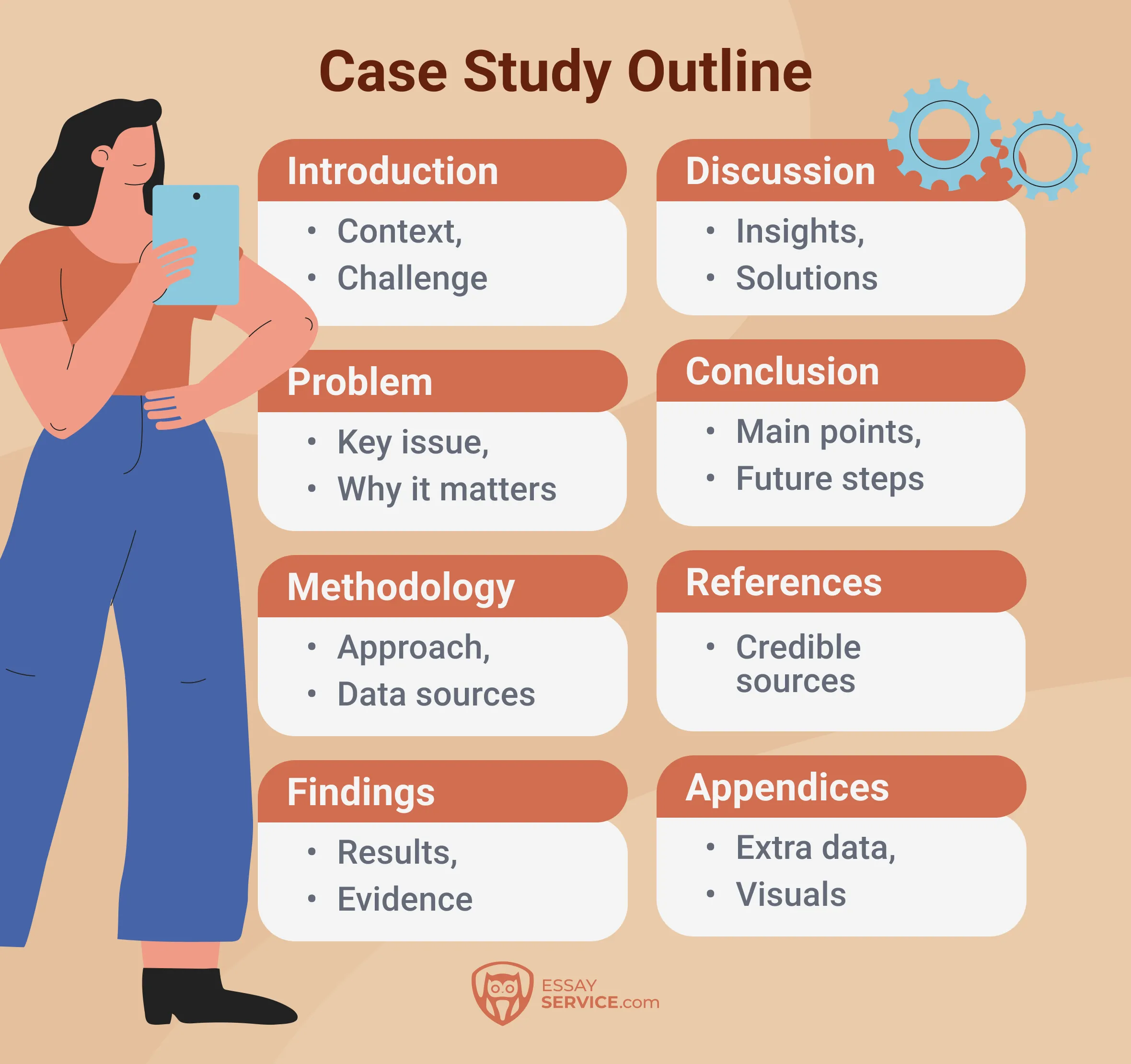Every strong case study begins with a map, and that map is the outline. According to the Content Marketing Institute, 75% of B2B marketers rely on case studies to prove value and attract new leads. In classrooms, most case studies in the social sciences or business courses follow a pattern of clear sections and relevant data that build into an engaging story.
The purpose of this article is to show students and professionals how a well-structured case study outline sharpens analysis and improves data presentation.
And, when deadlines feel heavy, our essay service gives students a helping hand with anything academic.

Understanding a Case Study Outline
An outline of a case study is basically the plan that shows where your background information should go, how to line up the data, and when to bring in the analysis so your paper feels clear instead of scattered.
Plenty of students try jumping straight from rough notes into writing. That almost always means repeated points or big gaps in the story. A simple outline fixes that problem. It gives you a place to sort the main ideas and decide where the evidence fits, so the reader doesn’t get lost.
With that kind of structure, the case study research you worked hard on actually lands. Readers follow the flow, and your case study feels like a complete story instead of a pile of disconnected details.
Wondering how to write a case study itself? Read our article and write confidently.
Core Sections of a Case Study Outline
An outline for case study, other than just organizing notes, shapes raw data into a story readers can follow. Each section pulls a different weight, and when one is missing, the whole piece feels unsteady. Outlines typically include:

- Introduction: This delivers background information that places the reader inside the problem’s setting.
- Problem: Every case study circles around a single tension point. The problem section identifies it directly.
- Methodology: Evidence gains strength when the process is transparent. Instead of saying 'data was collected,' detail how it happened.
- Findings: Data comes alive when presented with clarity. Pair numbers with customer experiences where relevant, so the audience sees both the measurable outcomes and the human side.
- Discussion: Results left alone can be misleading. This section interprets them and draws out possible solutions.
- Conclusion: The final section reminds readers of the main points and suggests how those lessons can guide future strategies.
- References: References, such as survey data, prior research, etc., anchor claims to sources and reassure readers that the case study rests on evidence, not opinion.
How to Create an Outline Case Study
Outlines are often sold as neat checklists. Collect information, arrange sections, add bullet points. But if you stop there, you get something flat. Here’s what to do:
- Start with the main problem: Name the exact issue, like falling customer satisfaction, a failed marketing strategy, or an overlooked factor. When you state the real center, the whole outline gets a direction.
- Show the chain of events: Don’t stop at describing what happened. Ask what chain reaction followed. For example, if a digital campaign brought in new leads, did it change how sales teams worked or shift who the target audience became?
- Keep it flexible: Research can reveal unexpected results or unique experiences. Leave space in your outline so you can add those without changing the structure.
- Use visuals wisely: Charts and tables should clarify the rest. Use them only when they show a pattern hidden in raw data. When a visual explains something better than text could, that’s when it’s valuable.
- Write for two kinds of readers: Some readers want a quick overview, while others look for details. Use clear headings for skimming and add supporting notes for those who want depth.
If you want to know the technical side of formatting, like margins, labels, and citation flow, read our blog on the MLA outline format for your next case study.
A Real Outline Template
Here’s a ready-to-use and free to download case study outline template PDF you can adapt for business, social sciences, or student projects. With the right structure, data becomes easier to present, and lessons learned reach the reader without distraction.
Case Study Outline Examples
Seeing the structure in action helps more than reading about it. Below are two case study outline examples that show how the same template can be adapted across fields:
1. Healthcare Case Study: Improving Patient Care
- Introduction / Background: A hospital sought to reduce emergency room wait times.
- Problem Statement: Long delays led to lower patient satisfaction and negative outcomes.
- Methodology: Analyzed patient records, interviewed staff, and tracked time data.
- Findings / Results: Adding triage nurses at intake cut wait times in half.
- Discussion / Analysis: Clear evidence showed staffing adjustments produced measurable improvements.
- Conclusion: Lessons learned can be applied in other departments.
- Recommendations: Continue monitoring outcomes and scale the approach.
2. Education Case Study: Student Retention
- Introduction / Background: A university wanted to improve first-year student retention.
- Problem Statement: Many students were leaving after one semester.
- Methodology: Collected survey data, focus group feedback, and enrollment records.
- Findings / Results: Strong advising programs and campus involvement boosted retention rates by 20 percent.
- Discussion / Analysis: Students who engaged socially and academically were more likely to stay.
- Conclusion: Identifying risk factors early made a major difference.
- Recommendations: Expand support programs and track long-term results.
Common Mistakes in a Case Study Outline
Outlines fail because what’s written doesn’t do the job it’s meant to do. These are the patterns that weaken it before writing case study even begins:

- Skipping the core problem: If the outline starts with background but never identifies the central issue, every later section drifts.
- Overloading sections: When charts, statistics, and side notes are crammed together, the reader can’t tell which details matter most.
- Weak Method description: Findings lose weight if the outline never explains how surveys, interviews, or data collection were handled.
- Disorganized results: Evidence scattered randomly hides the connections that show cause and effect.
- Uninterpreted findings: A table or figure that isn’t explained forces the audience to guess what it means.
- Flat conclusion: a conclusion that simply repeats data instead of extracting lessons leaves readers unsatisfied.
- Missing references: Without sources, the claims look like opinions rather than arguments.
- No appendix: Without an appendix, the core story gets buried under unnecessary detail.
Final Words
To write a case study, you need a strong outline. The outline is the spine. Without it, the whole body slumps. With it, the story stands up straight and carries its weight. Take the outline templates here and make them yours.
And if you ever feel the outline slipping through your fingers, EssayService sits in the wings. Buy essays or ask for whatever type of guidance you might need during studies. Sometimes a second set of eyes keeps the roof from caving in!
Frequently Asked Questions
How Do You Outline a Case Study?
Start with the case study problem, then stack background, methods, results, and lessons in a line that makes sense. Don’t let them spill into each other.
What Does a Case Study Template Look Like?
Case study templates are structured frameworks, with each section labeled to guide the writing process. These labels include: introduction, problem, methods, results, discussion, conclusion, references, and sometimes, the appendix at the end.
What Are Some Common Case Study Outline Mistakes?
Leaving the core problem unclear, adding too much information into one section, mentioning numbers but not elaborating, and forgetting to cite where the data came from.

Anna has been helping students become more productive learners for 20+ years now. Her experience, combined with a Master’s degree in psychology, ensures her blog posts contain only valuable insights.
- Content Marketing Institute. (2025). B2B content marketing benchmarks, budgets, and trends: Insights for 2025. Content Marketing Institute. https://contentmarketinginstitute.com/b2b-research/b2b-content-marketing-trends-research
- Monash University. (n.d.). How to write a case study. Student Academic Success. https://www.monash.edu/student-academic-success/excel-at-writing/how-to-write/case-study
- University College Dublin. (n.d.). Writing an impact case study. UCD Impact Toolkit. https://www.ucd.ie/impacttoolkit/communicate/writinganimpactcasestudy/
New posts to your inbox
Your submission has been received!


.webp)

